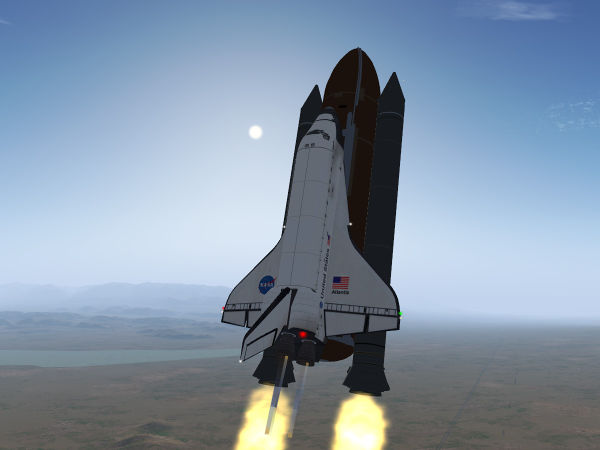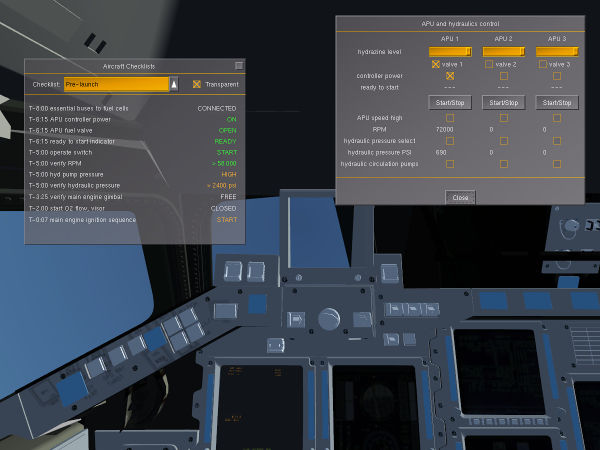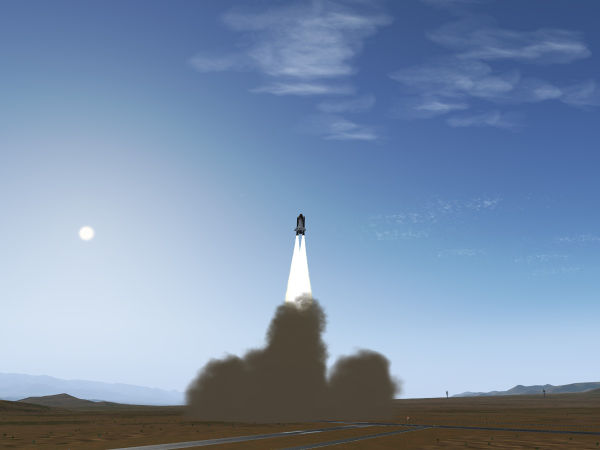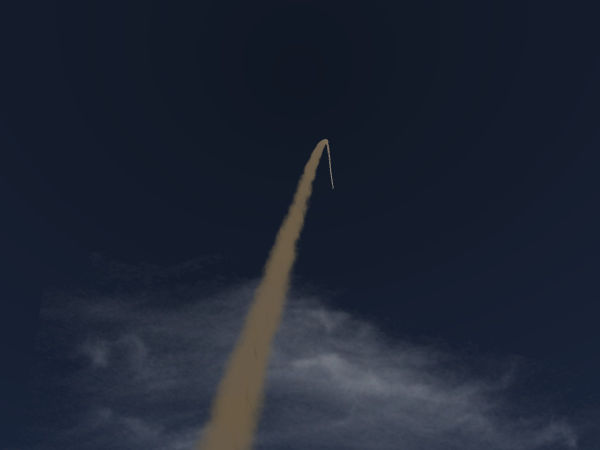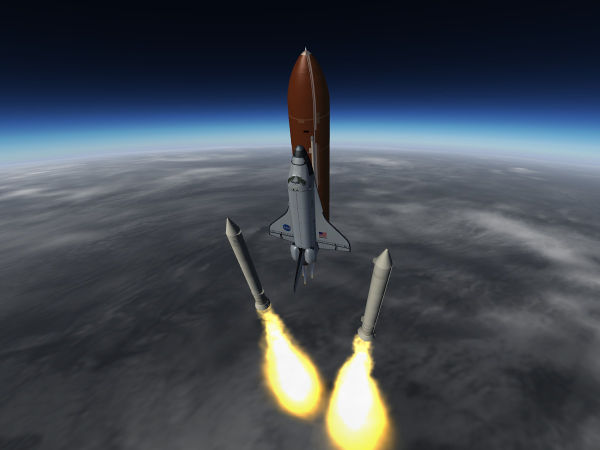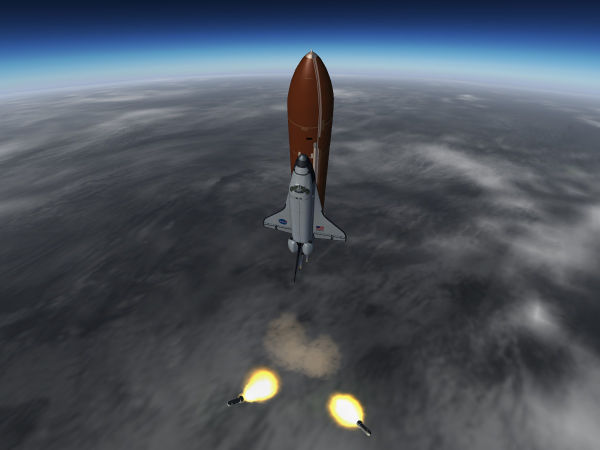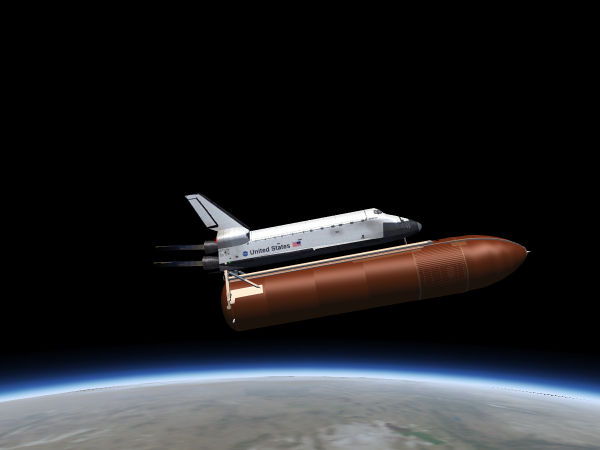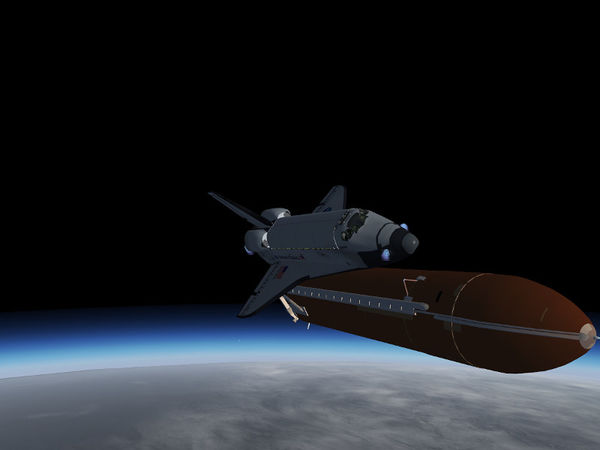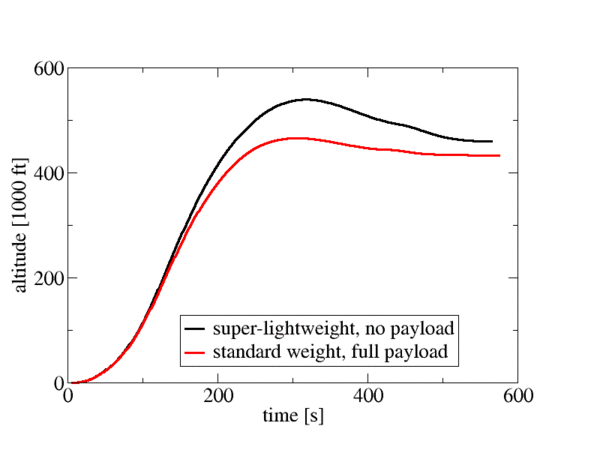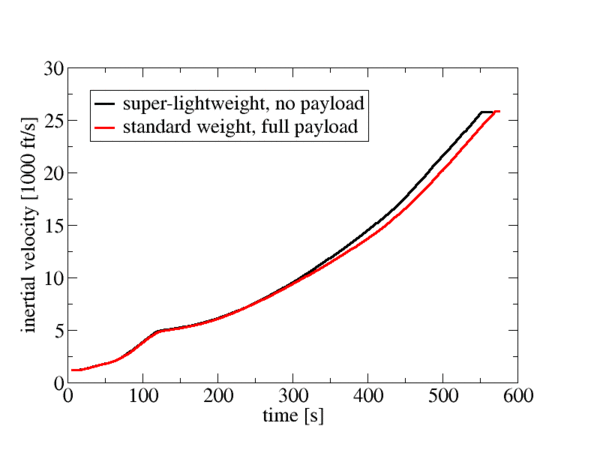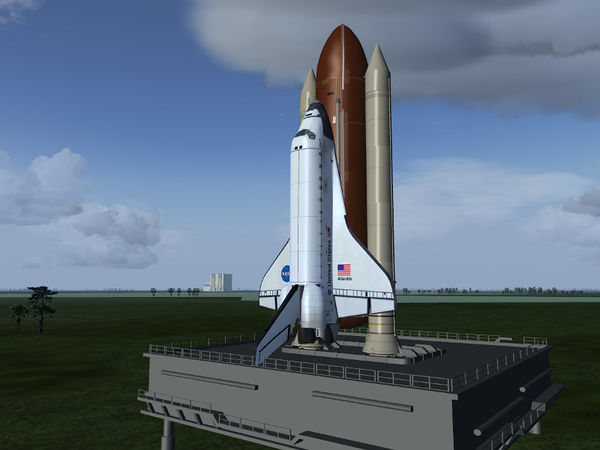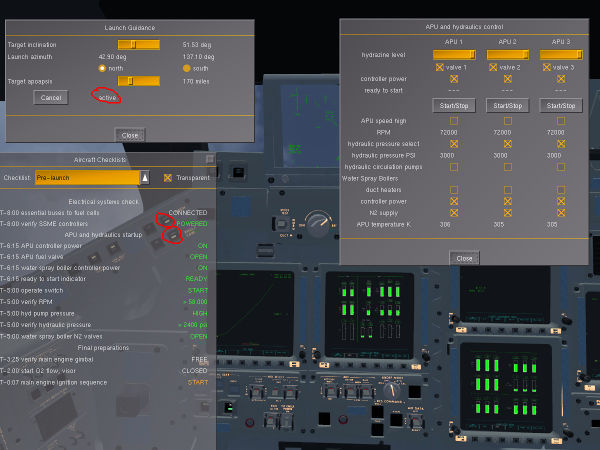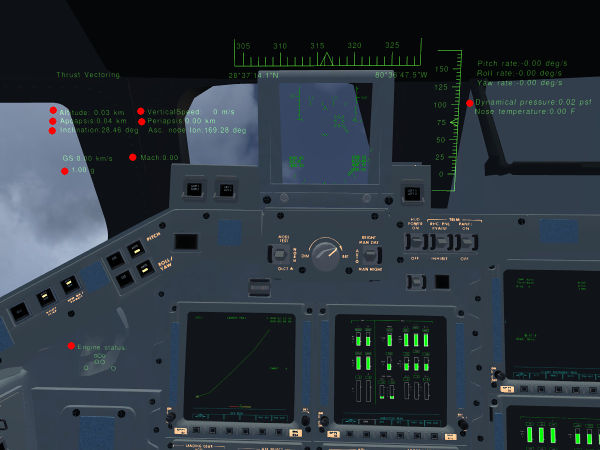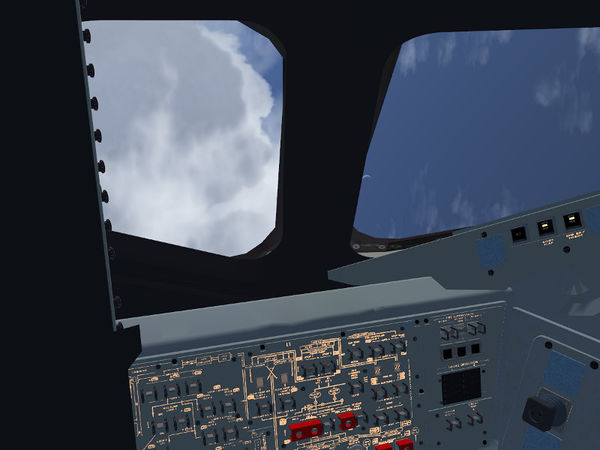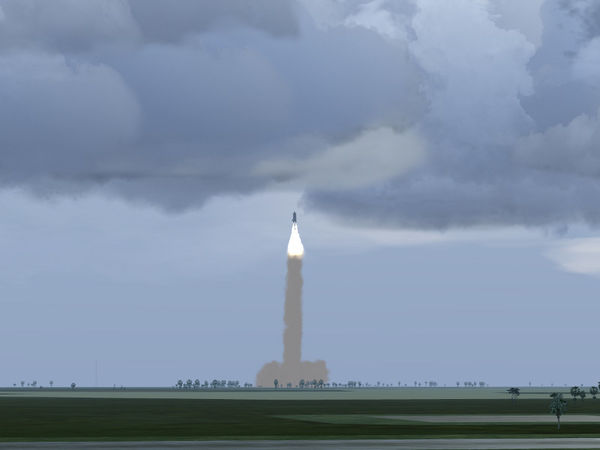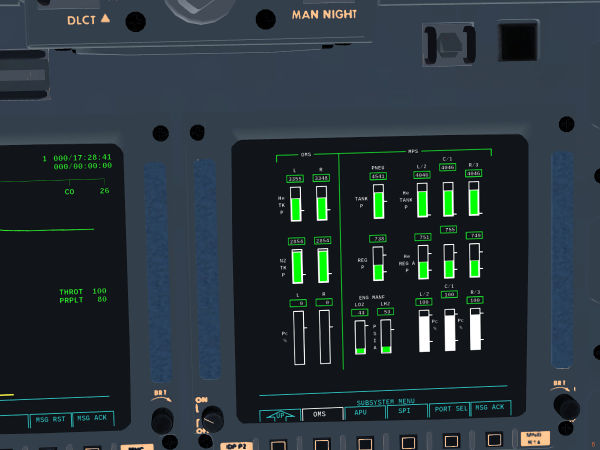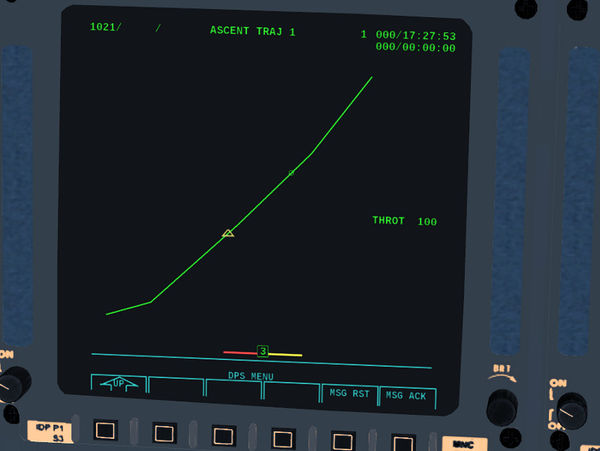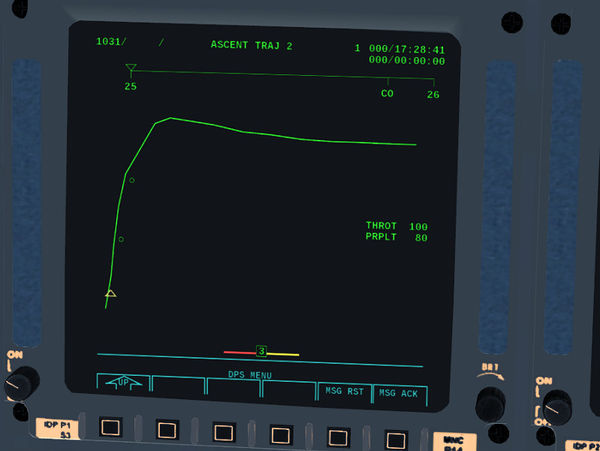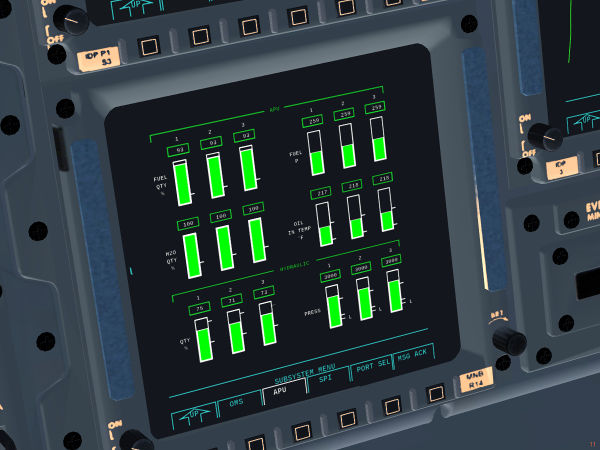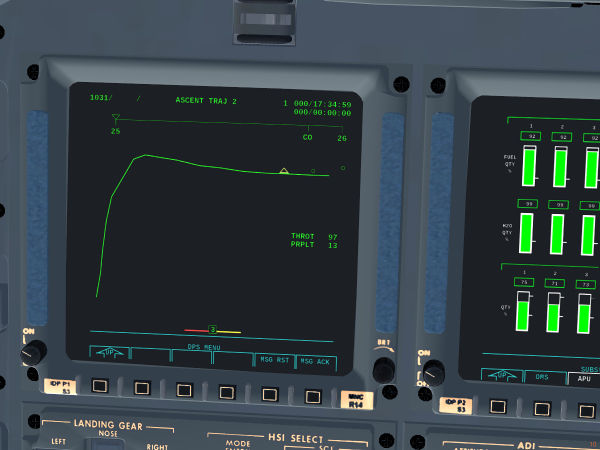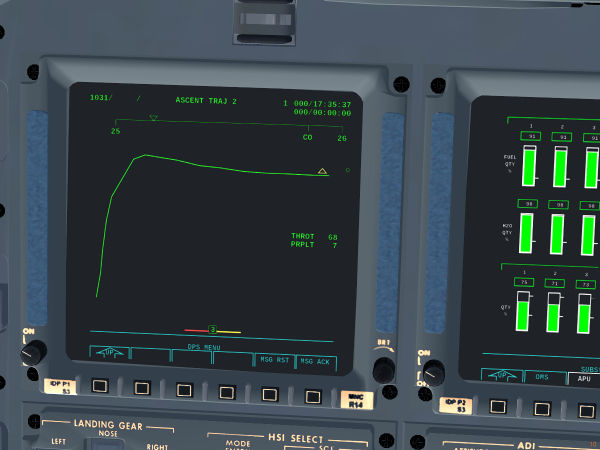Flying the Shuttle - Launch: Difference between revisions
| Line 147: | Line 147: | ||
[[File:Launch tutorial04.jpg|600px|And... we have liftoff. Atlantis is on her way!]] | [[File:Launch tutorial04.jpg|600px|And... we have liftoff. Atlantis is on her way!]] | ||
[[File:Launch tutorial06.jpg|600px|Launch tutorial 1]] | |||
[[File:Shuttle avionics ascent1.jpg|600px|ASCENT TRAJ 1 display of the Space Shuttle]] | [[File:Shuttle avionics ascent1.jpg|600px|ASCENT TRAJ 1 display of the Space Shuttle]] | ||
| Line 152: | Line 154: | ||
[[File:Shuttle avionics ascent2.jpg|600px|ASCENT TRAJ 2 display of the Space Shuttle]] | [[File:Shuttle avionics ascent2.jpg|600px|ASCENT TRAJ 2 display of the Space Shuttle]] | ||
Revision as of 17:56, 3 April 2016
| Space flight |
|---|
| in FlightGear |
| Space Shuttle |
| Vostok-1 |
| Note This article refers to the SpaceShuttle in the FGAddon repository. |
This mission phase can directly be started using --aircraft=SpaceShuttle-launch on the command line.
What are we trying to do?
The launch phase of the Shuttle lasts from ignition of the main engines until the shuttle reaches orbit. This is a surprisingly short time, all in all just about eight minutes. During this time, an enormous amount of propellant is spent accelerating the orbiter to Mach 26 at an altitude of 150 km. The complete launch stack consists of the orbiter, mounted on the external tank (ET) which supplies propellant for the Space Shuttle Main Engines (SSMEs), assisted by two solid rocket boosters (SRBs).
The first two minutes of the flight pass through the atmosphere, during this time the SRBs provide most of the thrust. The SRBs can not be throttled, once on, they burn till they are spent. At an altitude of about 150,000 ft the SRBs are disconnected and the shuttle accelerates only using the main engines fed from the ET which is disconnected just before reaching orbit.
The tasks are hence:
- Bring the orbiter safely through the atmosphere
- Steer towards a launch course corresponding to an orbit with the desired inclination
- Accelerate to orbital speed outside the atmosphere
Some theory
While Earth's gravitational force decreases with distance, the Shuttle doesn't reach even remotely high enough to experience weightlessness due to this effect. Rather, for low orbit spaceflight, weightlessness can be understood as gravitational force being balanced by centrifugal pseudo-force. The upshot is that in order to reach a stable orbit, the Shuttle needs to be moving fast - about 27.000 ft/sec, roughly 8 km/sec or Mach 27.
This velocity is something almost never referred to in aerodynamical flight - an inertial velocity with respect to the center of Earth. Since the planet rotates, this is not the same as a groundspeed. In fact, the planet rotates eastward fairly fast. The precise speed depends on latitude and is highest at the equator where it reaches a value of over 450 m/sec or 1450 ft/sec. The groundtrack of an orbit (i.e. the projection of the path of a spacecraft onto a globe) does hence not close even if the orbit itself is closed and is distorted by this effect.
The important implication is that launching close to the equator due east, we gain 1450 ft/s of inertial speed for free, whereas launching due west from the same location, we have to accelerate an extra 1450 ft/s. For this reason, launch courses always point eastward.
The next thing to consider is the inclination (i.e. under which angle will the desired orbit intersect with the equator). Trying to wrap a circle (the orbit) around a sphere (Earth), it is fairly easy to convince oneself that the only way to reach a zero inclination orbit is to launch from the equator and that no launch site at higher or lower latitude can lead to an inclination lower than that latitude in a straight launch.
If we aim to rendezvous with an object in orbit, we need to launch into the same orbital plane, and (short of long computations, see the linked website) that usually means launching into the same inclination when the target passes over the launch site. This is the reason we need control over the launch course.
Now, on an airless world, we could reach orbit a few hundered meters above the highest surface feature and get the same balance of centrifugal and gravitational force - there is no bonus for altitude. However, on Earth we can not reach Mach 27 at sea level - there is no material capable of withstanding the stresses and no thruster powerful enough to overcome the friction. Hence the acceleration to orbital speed needs to be above the atmosphere.
For this reason, a launch trajectory always has two parts. The first part is near-vertical and lifts the spacecraft out of the atmosphere, the second part is near horizontal and accelerates to orbital speed.
From an energetic perspective, the vertical part is wasteful and should be over as soon as possible. Imagine you have one g of thrust - it just allows you to overcome gravity and hover, but once your propellant is spent, you will fall down. This is the reason the SRBs are part of the launch stack - they generate a lot of thrust to get the shuttle out of the atmosphere as quickly as possible. It follows that it is wasteful if you want to reach an orbit of 600 km altitude to fly upwards to 600 km altitude and accelerate to orbital speed there - it costs far less energy to fly to 150 km altitude, accelerate to orbital speed there and later raise the orbit so that no energy is wasted fighting against gravity. For this reason, good launch tracks go out of the atmosphere but then stay low above it (of course, the spacecraft should not drop back into the atmosphere...).
As the acceleration depends both on thrust and the remaining mass of the stack (once the propellant is spent, the acceleration grows), the shuttle is initially highly maneuverable as long as the SRBs are burning, then thrust reduces dramatically and slowly grows towards the end as the ET depletes. Vertical launch trajectory management hence utilizes the enormous upward push of the SRBs to bridge the time till the main engine acceleration is strong enough to stabilize the trajectory vertically. In other words, after SRB separation vertical speed is initially high, then reduces due to gravity to even below zero (i.e. the tranjectory falls slightly) till the SSME and the centrifugal force push it up again, at which point it should be managed to near zero once injecting into orbit.
Finally, somewhat counter-intuitively, the spacecraft gains most of its kinetic energy in the last stages of the ascent. This can be understood in many different ways. One is to realize that initially propellant only has chemical energy, whereas in the late stages it has been accelerated, and so it has in addition kinetic energy which is released once it is used.
The implication is that during the first part of a launch, it is not necessary to keep the launch course very precisely, the inclination is mainly fixed in the last part of the launch. It is thus sufficient to correct launch course outside the atmosphere if the initial course is wrong.
How it feels in FG
The launch dynamics in FG is, if we neglect the noise and the shaking of the real thing (which is described as 'driving down a rough gravel road without any suspension, a shaking so hard the eyes cannot properly focus' as long as the SRBs are burning) probably fairly realistic.
As part of the pre-launch preparations, the APU and hydraulics subsystems has to be started to enable thrust vector control of the main engines during ascent. If this is not done, the Shuttle will cease to be maneuverable after SRB separation. The procedure is outlined in a checklist:
As soon as the throttle is moved to 65%, the main engines ignite. This is the starting signal for SRB ignition, the SRBs will follow three seconds later, and once they burn, there is no going back. The SRBs can not be throttled and will burn till exhausted, and they have enough thrust to lift the stack even if the main engine is switched off.
Upon ascent, the shuttle is controlled by thrust vectoring of both the SRBs and the SSME. About ten seconds after liftoff while the dynamical pressure is still small, roll the shuttle to the desired launch course, then pull slightly down to a pitch of 80-85 degrees of inverted flight (the journey into orbit is flown with the head hanging down). You should now verify that you are approximately (within 10-20 degrees) on your launch course. Don't worry about details, they can be fixed later.
At about 35 seconds into the flight, dynamical pressure (qbar) will rise rapidly as the stack goes supersonic. This is a dangerous phase of the flight. The stack is very top-heavy (as the heavy oxygen is stored in the tip of the ET and the light hydrogen in the bottom), so once it starts toppling, it won't come back. In addition, aerodynamical forces are very strong. In fact the very reason we do this phase in inverted flight is to reduce the wing loading. At the callout, reduce throttle of the main engines to 65% to minimize the pressure spike.
If you ascent is too flat in this phase, maximum qbar will be violated, or you may lose control of the stack beyond the point the thrust vectoring can recover. If the orbiter is not in inverted flight at this point, the wing bending moment will grow too large, ripping the wings of the orbiter, resulting in a catastrophic loss of vehicle. Do not attempt to cross max. qbar with positive AoA!
About 20 seconds later, max. qbar is over and the stack becomes much more controllable. Throttle up to full and gradually reduce pitch to about 60 degrees (still inverted) and keep rising.
Seen from the ground, the smoke trail of the launch shows clearly the point at which the shuttle departs from vertical ascent and reduces pitch.
At around 150,000 ft altitude, the SRBs separate. They're still burning for a while, but they won't generate any thrust. While they seem to fall back, they actually continue to rise - just the shuttle accelerates away from them at a faster pace.
With the SRBs gone and most of the fuel still in the tank, thrust is down from abut 2.5 g to less than 1 g - which means that the stack no longer gains vertical velocity. Nevertheless, there's still a tremendous vertical velocity left, so the shuttle will continue to rise until this is depleted.
Outside of the atmosphere, handling characteristics are much improved, but there's now no friction, so every motion has to be explicitly canceled. Time to fine-tune the launch course - watch inclination in the HUD to insert into an orbit at a given inclination now.
Pitch should be gradually reduced to about 30 deg, still in inverted flight. The reason for this is communication (not implemented in FG) – at this point the Shuttle has contact to ground stations in the Caribbean for a proper launch trajectory. Watch vertical velocity and adjust pitch to get it to zero out at about 150 km altitude. Watch launch course and don't allow large deviations any more – they will reduce your reserves to make orbit.
You will almost inevitably drop in altitude for a bit from there – that's normal, and it'll recover once the ET gets light when all the fuel is spent and thrust increases. Roll out of inverted flight about 5 minutes into the launch to be realistic (the shuttle makes now communication via the satellite network and no longer directly with the ground).
What should not happen is that the trajectory drops below 265.000 ft – the reason is ET heat load. The ET is equipped with an ablator to take care of the worst of friction heat, but if you go too fast too low, the heat shield will fail and the ET will explode.
At this stage, the thrust vector is not very aligned with the shuttle axis – note how the SSME pointed out of the axis push through the ETs top-heavy CoG:
Once the ET depletes, thrust builds up. Watch acceleration and throttle back to keep it below 3 g (which is the structural limit of the stack on ascent). Manging vertical velocity should be easy at this point, there's plenty of thrust so that pitch has an immediate and strong effect on vertical speed. Keep it close to zero and maintain 150 km altitude. Keep an eye on the perigee counter now - once you are close to orbital velocity, it moves fast. Reduce thrust as soon as it comes above zero, cut thrust once the apogee reaches the desired value and drop the external tank. The RCS will fire automatically in translational mode to separate the orbiter from the tank.
The final push into orbit is done by the orbital maneuvering system (OMS). The reaction control system (RCS) will come on automatically, enabling you to null any remaining rotation of the orbiter.
In reality, propellant is calculated rather closely to the needs. In FG, without a payload, especially launching due east, you may arrive in orbit with some leftover propellant, potentially enabling to reach a rather high orbit. Take on a heavy payload and launch on a high inclination, and that may change.
Good luck, you're ready to do orbital maneuvering.
Trajectory Data
The following data has been recorded from the FG Space Shuttle simulation, i.e. they reflect the capabilities of the simulated craft (including piloting errors) and are actually flyable. They may serve as orientation for a viable launch trajectory with and without payload.
In each case, the launch was from Vandenberg AFB with an initial launch course due East (this is reflected in a non-zero initial inertial velocity, representing the Eastward turning of Earth). In all cases, the launch targeted an apogee of 250 km with a perigee below 100 km to make sure the ET would re-enter the atmosphere.
Altitude vs. time shows a clear transition from vertical motion to get out of the atmosphere to horizontal motion to accelerate to orbital speed at an altitude of about 450.000 ft (135 km) at about 250 s into the flight. This transition is lagging behind the commanded trajectory, the transition to a near-horizontal attitude happens in fact much earlier shortly after SRB separation at around 120 s. Note that a modest trajectory droop back from a peak altitude is perfectly acceptable and completely unproblematic for reaching orbit as long as the trajectory does not enter the dense atmosphere below 300.000 ft (100 km).
The most prominent structure in the intertial velocity development over time is the sudden drop in acceleration at SRB separation (about 120 s into the flight). The presence/absence of a payload is chiefly visible in the late stages of the flight and leads to about 10 seconds difference in MECO time. For the heavy launch, the remaining propellant after MECO was ~33.000 lb, i.e. the tanks do not need to be flown dry and the Shuttle is quite capable of lifting a payload into a higher inclination orbit.
Three, two one... ignition and... liftoff - a launch tutorial
| Work in progress This article or section will be worked on in the upcoming hours or days. See history for the latest developments. |
(written for the devel version of April. 2016)
In this tutorial, you'll learn how to program a launch into the Shuttle's guidance system, what happens during a launch and how to monitor ascent into orbit.
- Start Flightgear with the commandline options
--aircraft=SpaceShuttle-launch --lat=28.6206 --lon=-80.6133 --heading=270 --timeofday=morning
You'll find yourself on a pad in launch complex 39 at the cape, on a hot Florida morning. You have in fact just a few minutes to liftoff. (There's no launch gantry, flame trench, access road,... because no 3d modeler has put it there yet).
If you toy with the idea that specifying a heading is silly, be warned - it's crucial for the launch guidance to find a viable solution that the tail fin of the Shuttle points into the Eastern hemisphere - keep this in mind if you want to launch from somewhere else in the world.
- Now, in reality the launch has been in planning for months if not years, and all guidance information is already loaded and cross checked at this point. FG doesn't (yet) support mission files or similar, so we need to tell the computer where we want to go. Open SpaceShuttle -> Launch guidance, select a target inclination of 51.5 degrees or so (that'd be required for a launch to ISS), leave the branch and target apoapsis as they are (you'll go to a 320 km orbit) and press Activate. The guidance now knows where to go.
Next, tell the Shuttle that you want the flight on autopilot by selecting the PITCH AUTO and ROLL/YAW AUTO pushbuttons on the forward panel (circled in red, underneath the transparent checklist).
Flying the Shuttle manually into orbit isn't actually difficult at all - if you know what you have to do, because you need to anticipate a few things and that's what we're out to learn here. But if you want to take over from the automatic guidance at any point, push the CSS pushbutton for the channel (you can just take control of pitch and let the DAP handle yaw/roll for instance). After activating CSS in-flight, do not attempt to hand control back to the AP - this will not work!.
- There's also real-world stuff you need to do in cockpit. Open Help -> Aircraft Checklists and study what we have to do for launch. Engine controllers need to be powered (obviously) - they should already be. APUs need to be running and supplying hydraulic power to gimbal the engines. That we still need to do. Open Space Shuttle -> APU and hydraulics and follow the items in the checklist to start all three APUs and bring hydraulic pressure to 3000 psi (hint: the sequence in which you work actually matters).
Okay, there's a few other items which you can't yet perform on the list (it's the original from the Shuttle's Crew manual), so we're good to launch as soon as engines ignite.
- While you wait, take a look at the FG-native HUD layer:
Further reading
NASA human space flight page on Shuttle First Stage
